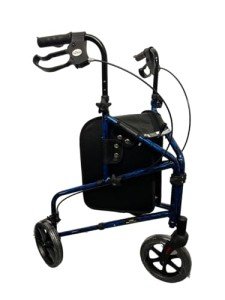folding-rollator1145
folding-rollator1145
What’s The Job Market For Walking Frame Professionals Like?

Understanding Walking Frames: Features, Benefits, and Considerations
Walking frames, likewise referred to as walkers, are essential mobility aids developed to offer stability and assistance for individuals who may fight with balance, coordination, or strength when moving. These devices can substantially boost the quality of life for the elderly, individuals recovering from surgery, and those with chronic health conditions impacting mobility. This short article will explore the different types of walking frames, their benefits, correct usage, and key factors to consider for users and caretakers.
Types of Walking Frames
Walking frames been available in several variations to accommodate various user needs. The main types consist of:

-
Standard Walking Frames: These are basic freestanding frames that offer optimal stability. Users should raise the frame with each action, making them suitable for individuals with good upper body strength.
-
Two-Wheeled Walkers: These frames have two front wheels, enabling smoother motion. They are ideal for users who can handle some weight-bearing and need less lifting.
-
Four-Wheeled Walkers (Rollators): Designed with 4 wheels, a seat, and hand brakes, rollators offer benefit and safety. Users can stroll without lifting the frame, making them ideal for those with limited stamina or strength.
-
Knee Walkers: These are created for people recuperating from foot or ankle injuries. Users rest their knee on a cushioned cushion while pressing themselves forward with their other leg.
Table 1: Comparison of Walking Frame Types
| Walking Frame Type | Main Features | Best Suited For |
|---|---|---|
| Basic Walking Frame | No wheels; needs raising | Users with excellent upper body strength |
| Two-Wheeled Walker | Front wheels; easier maneuvering | Users needing moderate support |
| Four-Wheeled Walker | Wheels, seat, brakes | Users requiring stability and rest choices |
| Knee Walker | Cushioned knee rest; mobile | Users with lower leg injuries |
Benefits of Using Walking Frames
Walking frames use numerous benefits that boost mobility and promote self-reliance. These benefits consist of:
-
Increased Stability: Walking frames supply a stable platform, reducing the risk of falls.
-
Improved Confidence: By using support, users can feel more safe and secure while walking, which improves their confidence in mobility.
-
Flexible Use: Walking frames can be utilized inside and outdoors, accommodating numerous surface areas and environments.
-
Minimized Physical Strain: They relieve the physical concern on the user’s legs and back, permitting people with discomfort or weakness to walk longer ranges.
-
Motivation of Physical Activity: Regular use can promote mobility and help maintain physical activity, which is important for overall health.
Key Considerations for Users and Caregivers
While walking frames use considerable benefits, there are several crucial considerations to make sure optimal use:
-
Proper Fit: Walking frames should be gotten used to the correct height for the user. When standing straight, the elbows must be slightly bent when holding the manages.
-
Weight Capacity: Each walker has a maximum weight limitation. Users should ensure they pick a walking frame that can properly support their weight.
-
Terrain Suitability: Users need to think about where they will primarily use the walker. Four-wheeled walkers are much better fit for outdoor use on unequal surfaces.
-
Maintenance: Regular checks on brakes, wheels, and structural integrity are essential to guarantee safety.
-
User Training: Proper training from healthcare professionals can assist users and caretakers understand how to use walking frames safely and effectively.
Frequently Asked Questions about Walking Frames
-
Who can gain from using a walking frame?
- People with balance issues, elderly people, those recuperating from surgery, and those with persistent mobility concerns can take advantage of using walking frames.
-
Can walking frames be used outdoors?
- Yes, numerous walking frames, particularly four-wheeled walkers, are developed for both indoor and outdoor use.
-
How do I pick the ideal walking frame?
- Consider your mobility needs, environment, weight capability, and any additional functions like seats or storage compartments.
-
What should I do if I feel unsteady using a walking frame?
- Speak with a healthcare expert or physical therapist for guidance on correct use and adjustment of the walking frame.
-
Are there any threats related to using a walking frame?
- If not used correctly, walking frames might result in falls. It’s important to guarantee correct fit, change them properly, and practice safe walking strategies.
Walking frames represent an important tool for increasing mobility and independence for lots of people facing physical difficulties. By understanding the different types available, their benefits, and the considerations associated with their use, users and caretakers can make educated decisions about selecting and making use of the ideal walking frame. With the best support, many people can regain confidence in their mobility, enhance their lifestyle, and take essential actions towards independence.




